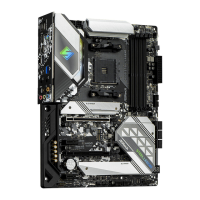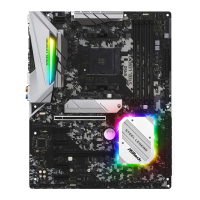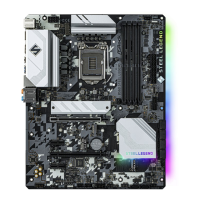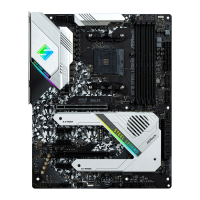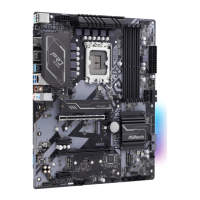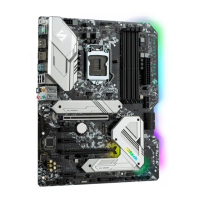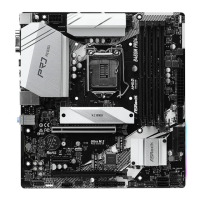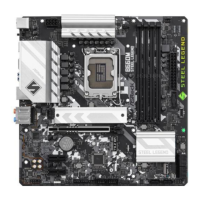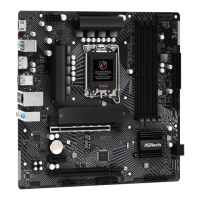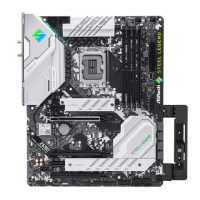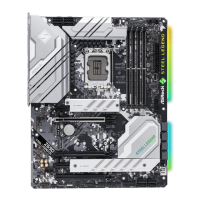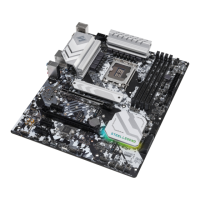
Do you have a question about the ASROCK H670 Steel Legend and is the answer not in the manual?
| Processor socket | LGA 1700 |
|---|---|
| Processor manufacturer | Intel |
| Compatible processor series | Intel Celeron, Intel Core i3, Intel Core i5, Intel Core i7, Intel Core i9, Intel Pentium |
| Maximum number of SMP processors | 1 |
| Memory channels | Dual-channel |
| Memory slots type | DIMM |
| Unbuffered memory | Yes |
| Number of memory slots | 4 |
| Supported memory types | DDR4-SDRAM |
| Maximum internal memory | 128 GB |
| Supported memory clock speeds | 5000 MHz |
| DisplayPort version | 1.4 |
| USB 2.0 ports quantity | USB 2.0 ports have a data transmission speed of 480 Mbps, and are backwards compatible with USB 1.1 ports. You can connect all kinds of peripheral devices to them. |
| VGA (D-Sub) ports quantity | 0 |
| USB 3.2 Gen 1 (3.1 Gen 1) Type-A ports quantity | 2 |
| Number of M.2 (M) slots | 3 |
| Maximum resolution | 7680 x 4320 pixels |
| Parallel processing technology support | Crossfire |
| Audio chip | Realtek ALC897 |
| Component for | PC |
| Motherboard chipset | Intel H670 |
| Audio output channels | 7.1 channels |
| Motherboard form factor | ATX |
| Wi-Fi | No |
| LAN controller | Dragon RTL8125BG |
| Ethernet interface type | 2.5 Gigabit Ethernet |
| Cables included | SATA |
| BIOS type | UEFI AMI |
| ACPI version | 6.0 |
| BIOS memory size | 128 Mbit |
| System Management BIOS (SMBIOS) version | 2.7 |
| RAID levels | 0, 1, 5, 10 |
| Supported storage drive types | HDD & SSD |
| Supported storage drive interfaces | M.2, SATA III |
| Harmonized System (HS) code | 84733020 |
| Weight | 1000 g |
| Depth | 244 mm |
|---|---|
| Width | 305 mm |
| Height | 70 mm |
Lists all components included in the motherboard package.
Details the technical specifications of the motherboard, including platform, CPU, chipset, memory, and slots.
Provides a visual diagram of the motherboard with numbered components and connectors.
Illustrates and describes the rear panel connectors and their functions.
Important safety and handling guidelines to follow before installing motherboard components.
Step-by-step guide for safely installing the CPU into the motherboard socket.
Instructions on how to mount the CPU cooler assembly onto the motherboard.
Guide for correctly inserting DDR4 memory modules into the DIMM slots.
Information on the different PCIe slot types and their configurations for expansion cards.
Explanation of jumper settings, focusing on the Clear CMOS jumper.
Details on connecting front panel headers, power, and other onboard connectors.
Instructions for using the BIOS Flashback feature via the smart button.
Explains the function of the Post Status Checker (PSC) for diagnosing boot issues.
Guide for installing and configuring multiple graphics cards using AMD CrossFire technology.
Steps for installing graphics drivers and setting up AMD CrossFire.
Instructions for installing M.2 WiFi/BT modules and Intel® CNVi.
Guide for installing M.2 SSDs into the M2_1 slot.
Guide for installing M.2 SSDs into the M2_2 slot.
Guide for installing M.2 SSDs into the M2_3 slot.
Instructions for installing essential drivers from the support CD for system functionality.
Guide to installing and using ASRock's A-Tuning software for system monitoring and control.
Overview of ASRock's online store for downloading software, drivers, and utilities.
Explains the user interface layout of the ASRock Live Update & APP Shop.
Details on how to find, install, and manage applications from the ASRock APP Shop.
Instructions for updating BIOS and drivers through the ASRock Live Update & APP Shop.
Guide to configuring Nahimic audio settings for enhanced sound performance.
Information on using ASRock Polychrome SYNC for RGB lighting customization.
Introduction to the UEFI SETUP UTILITY and how to access it.
Description of the EZ Mode interface for quick system status overview.
Overview of the Advanced Mode for detailed BIOS configuration options.
Details the main menu bar options within the UEFI Setup Utility.
Explains the keyboard shortcuts and navigation keys used in the UEFI utility.
Describes the Main screen, which provides a system overview upon entering UEFI setup.
Guide to the OC Tweaker screen for configuring overclocking settings.
Overview of the Advanced screen for system configuration.
Details CPU-related settings for performance and power management.
Configuration options for the motherboard's chipset and connected devices.
Settings for managing SATA controllers, M.2 slots, and storage devices.
Configuration options for Intel Thunderbolt support and boot features.
Settings related to Super IO devices, such as PS/2 ports.
Advanced Configuration and Power Interface settings for power management.
Settings for managing USB controllers, including legacy support.
Configuration options for Trusted Platform Module (TPM) and security features.
Access to various utility tools like Instant Flash, RAID installer, and SSD tools.
Monitors system hardware status, including CPU temp, fan speed, and voltages.
Settings for managing BIOS supervisor and user passwords, and Secure Boot.
Configures boot order, fast boot options, and CSM settings.
Options for saving changes, discarding changes, and loading default settings.

